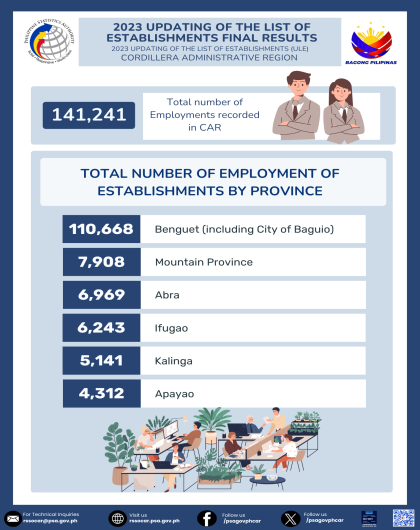The Labor Force Survey (LFS) is a nationwide quarterly survey of household conducted by the Philippine Statistics Authority (PSA) to gather data on the demographic and socioeconomic characteristics of the population. The LFS provides a snapshot or the stock of economically active persons in the country at a particular point or reference period. It aims to monitor the changes in the employment status of persons in the working age population during a specified time period using the Labor Force Framework. The LFS concept and measurement follows the international standards concerning statistics of the economically active population, employment, unemployment and underemployment. These standards were adopted during the 13th International Conference of Labour Statisticians (ICLS) in October 1982 at Geneva, Switzerland.
CAR Labor Force Participation Rate (LFPR) is 62.2%
- The results of the January 2018 Labor Force Survey showed that the Philippines’ labor force participation rate was estimated at 62.2 percent or about 44.1 million individuals. This means that six in every ten individuals aged 15 years old and over were either employed or unemployed.
Figure 1. Labor Force Participation Rate by Region, Philippines: January 2018
-
Cordillera Administrative Region (CAR) has an LFPR equal to the national rate of 62.2 percent. The region’s LFPR increased by 1.1 percentage points from 60.1 percent in January 2017 to 62.2 percent in January 2018.
-
Northern Mindanao posted the highest LFPR with 72.0 percent that translates to about 2.4 million individuals. The Autonomous Region of Muslim Mindanao (ARMM) had the lowest LFPR with 46.1 percent.
- The number of employed persons in the region in January 2018 was estimated at 757,404 individuals. This increased by 2.5 percentage points from 93.9 percent in January 2017 to 96.4 percent in January 2018.
61.5 % of employed persons in CAR are males
- Of the estimated 757,404 employed persons in CAR in January 2018, 61.5 percent or about 465,848 individuals were males, while 38.5 percent or about 291,555 individuals were females.
-
Employed males in the region increased by 0.6 percentage point from 60.9 percent in 2017 to 61.5 percent in 2018. A corresponding decrease of 0.6 percentage point was recorded among the employed females from 39.1 percent to 38.5 percent in the same period.
Most of the employed have high school education
- As to the highest grade completed of employed persons, those who had Junior High School education dominated the labor force with 38.7 percent, of which 27.0 percent or about 204,643 individuals graduated while 11.7 percent or about 88,338 individuals did not graduate.
-
Employed persons with college education followed with 32.4 percent of the total employment in the region. Of these, 20.3 percent were graduates while 12.2 percent were undergraduates. College education includes post baccalaureate undergraduates and graduates.
-
Employed persons with elementary level education came third with a share of 23.5 percent, of which 10.2 percent graduated while 13.3 percent did not graduate.
-
Employed persons with Post-Secondary level education accounted 3.2 percent of the total employed persons in the region. There were 3.2 percent employed persons who finishedthe course.
-
The percentage of employed persons with no education or grade level completed was at 1.9 percent. This was the second lowest share to total employment in the region next to those with Senior High School education.
Service industry employs the most
- By industrial origin, Service industry employed the most with 42.3 percent share in January 2018 followed by the Agriculture industry with 42.2 percent. Industry had the least share in the regional total employment in the same period with 15.6 percent.
-
By sub-industry, Agriculture, Hunting and Forestry continued to be the biggest employer in the region with 42.1 percent share in January 2018 or about 319,041 workers.
-
Wholesale and retail trade, repair of motor vehicles and motorcycles ranked as the second largest sub-industry group with 11.7 percent of the total employed persons in the same period in 2018, followed by public administration, defense and compulsory social security with 9.1 percent.
-
Manufacturing shared 2.8 percent to the total employment in the region in January 2018.
- Among the occupation groups, elementary occupations comprised the largest group of employed persons in CAR with 26.7 percent of the total regional employment in January 2018. This increased by 0.6 percentage points from 26.1 percent in January 2017.
-
Skilled agricultural, forestry and fishery workers ranked the second largest occupation group with 26.2 percent of the total employed persons. The percentage of employed persons in the group did not post any significant change in January 2017 and 2018.
-
Managers made up the third largest occupational group in January 2018 accounting for 13.4 percent in the total regional employment.
- The underemployment rate in the region in January 2018 was at 14.8 percent. This decreased by 2.5 percentage points from 17.3 percent in the same period in 2017. The visible underemployment rate was estimated at 7.1 percent in January 2018.
-
The total underemployment in CAR was estimated at 112,418 individuals of which 51.9 percent of the underemployed persons were already working 40 hours per week and over.
-
Meanwhile, those who work less than 40 hours a week accounted 48.1 percent of the total underemployed persons in the region.
- Unemployment rate in the region decreased by 2.5 percentage points, from 6.1 percent in January 2017 to 3.6 percent in January 2018.
-
Unemployed females decreased by 7.3 percentage points or from 38.2 percent in January 2017 to 30.9 percent in January 2018. The observed decrease on the percentage of unemployed females correspond to the increase in the percentage of unemployed males.
Technical Notes


